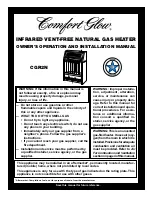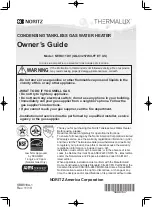
EN
8
TECHNICAL DESCRIPTION
The water heater is intended for domestic purposes in households,
and can provide hot water from the common water main system
simultaneously for a few consumers – kitchen, bathroom and etc.
The heated water should be correspond to the normative
documents for domestic water and, in particular: its chlorides
composition should be less than 250 mg/l and its electric
conductivity should be more than 100 µS/cm, while its pH within
the limits of 6.5-8 for the water heaters with enameled water tanks,
and electric conductivity less than 200 µS/cm for the water heaters
with chrome-nickel steel water tanks. The water pressure in the
water supply system should be higher than 0.1 MPa and lower
than 0.5 MPa. If the water pressure is higher than 0.5 MPa - please
refer to the instructions in the section for connection to the water
supply network. Special water heater models are in production (for
regions where local regulations require) with design to work in
plumbing pressure up to 1 MPa.
The appliances water containers (water tanks) are properly
protected against corrosion by using high quality enameled
coating, or are made of high-range alloy chrome-nickel (corrosion
resistant) steel. Water tanks with enameled coating are equipped
with built-in anodes made of special alloy providing additional
protection.
The outer casing of the appliances is made of epoxy-polymer
coverage and the heat insulation is made of CFC-free
polyurethane foam.
Schematic views of the basic models with their modifications are
shown in Fig. 1-7, and technical specifications – in Tables 1, 1a, 2
and 2a. All figures and tables are located at the beginning of this
booklet.
The water heater models are marked with letters and digits as
follow:
џ
The first two letters and the following five digits indicate the
device base model.
џ
„W“ – the devices are designed for premise wall mounting.
џ
„V“ – the water heater can be installed only in a vertical
position.
џ
„H“ – the water heater can be installed only in a horizontal
position.
џ
„U“ – the water heater is with a universal mounting - can be
installed in a vertical or in a horizontal position.
џ
xxx – the first three digits after the letters „V“, „H“ or „U“, are
code for the water tank capacity range of the water heater.
џ
yy – the next two digits are code of the device diameter.
џ
„А“ – in the enameled water tank is built-in an anode tester
indicating the level of corrosion protection and anode wear,
Fig. 1а, pos. 6
џ
„I“ – the water tank of the appliance is made of chrome-nickel
steel alloy.
џ
„S“, „S2“, „S21“ and „Т“ – in the water heater are built-in one or
two heat exchangers for water heating from an alternative
heat source (local water heating, solar collector and any other
similar sources), Fig. 4 for „S“ and „S2“, Fig. 5 for „S21“ and
Fig. 6 for „Т“. Water heaters with a heat exchanger designed
for horizontal installation, are shown in Fig.7.
џ
„L“ – the outlets of the heat exchanger and/or pipes for cold
and hot water of some vertical and horizontal water heaters
are located on the left side of the wall-mounted unit.
џ
„R“ – the outlets of the heat exchanger and/or pipes for cold
and hot water of some vertical and horizontal water heaters
are located on the right side of the wall-mounted unit.
џ
„B“ – the outlets of cold/hot water pipes of horizontal
water heaters are located below of the wall-mounted unit.
џ
„D“, „C“ – within the water heaters are built-in up to
two electric heaters located in special tubes on the water
tank flange. It improves the appliance safety of the device
while increasing corrosion resistance. "D" - with tubular
metal heating element, to 1,6 kW for units with a capacity up
to 50 l (volume groups 30 and 50), up to 2 kW for units
with a capacity of up to 100 l (vol. groups 80 and 100) and
up to 2,4 kW for all others. "C" - with ceramic heating
element, 1,5 kW for units in volume group 50, and up
to 2,2 kW for the remaining.
џ
„Е“, „Еxy“ – the water heater is equipped with electronic
control unit for the heater or for water heaters with heat
exchangers - for the heater and the devices for coolant flow
control, Fig. 1b. These appliances are accompanied by
additional instructions describing how to use the digital
control unit.
The hot and cold water pipes are marked with colored pointers,
respectively red and blue.
The water heater power (excluding those with letters "D" and "C")
is 1,5 kW for the units in volume group 30, up to 2 kW for the units in
group 50 and 3 kW for the rest.
The exact and complete model number, nominal operating
parameters and serial number of purchased water heater are
marked on manufacturer plate affixed on its body.
Water heaters for vertical installation. These models of heaters
are designed for mounting only in a vertical position with cold and
hot water pipes downward, Fig. 1 Fig. 4-6.
Water heaters for horizontal installation. These models of
heaters are designed for mounting only in a horizontal position in
accordance with the schema designed for each model number,
Fig. 2 Fig. 3 Fig. 7
Water heaters for universal installation. These models water
heaters are designed for optional vertical (Fig. 1), or horizontal
installation (Fig. 2).
WARNING! When the water heater with universal installation is
mounted in a horizontal position IT IS MANDATORY that the
pipes for hot and cold water, and its electric control be on its left
side, see Fig. 2. Failure to do so will make the unit dangerous
and the manufacturer and / or the trader shall not assume any
responsibility for occurrence of any adverse effects and
damages!
Water heaters with heat exchanger. The water heaters of these
models secure an energy efficient operation thanks to their built-in
heat exchangers. The heat exchanger(s) outlets locations and
their basic installation distances are shown on Fig. 4, 5, 6, 7 and
Tables 2 and 2a. By using a heat exchanger bigger quantities of
water inside the water container can be heated through an
additional alternative energy source, i.e. local or central heating
system, solar collectors and other similar sources. For more
efficient heat exchanger use it is recommended to move the heat-
transfer liquid with a circulation pump. For heat-transfer liquid can
be used water with composition and index values within the levels
laid down in the regulations related to water or a dedicated
aqueous solution which is not aggressive to heat exchanger
































